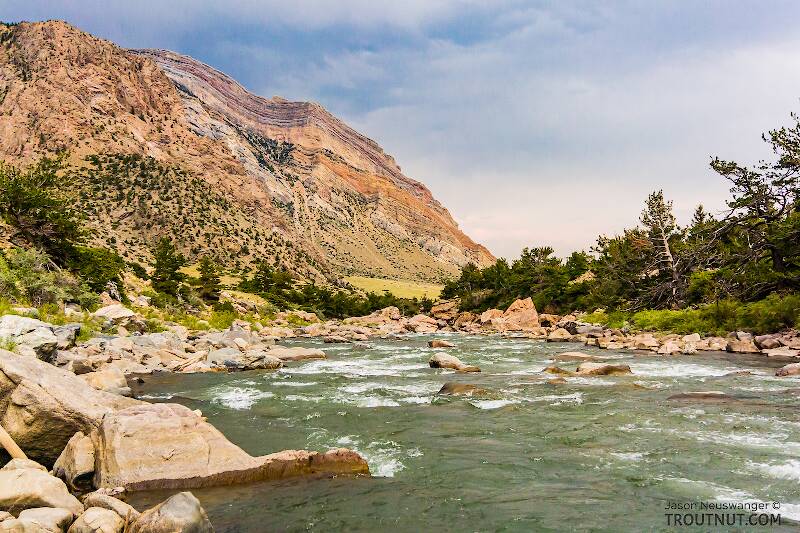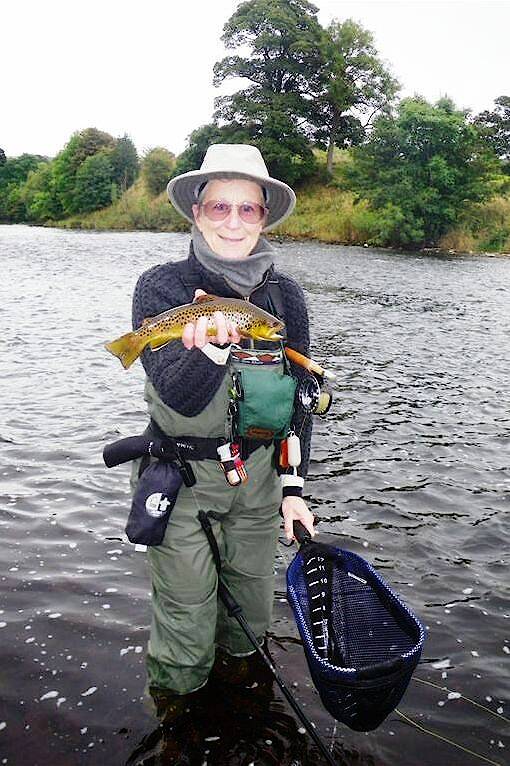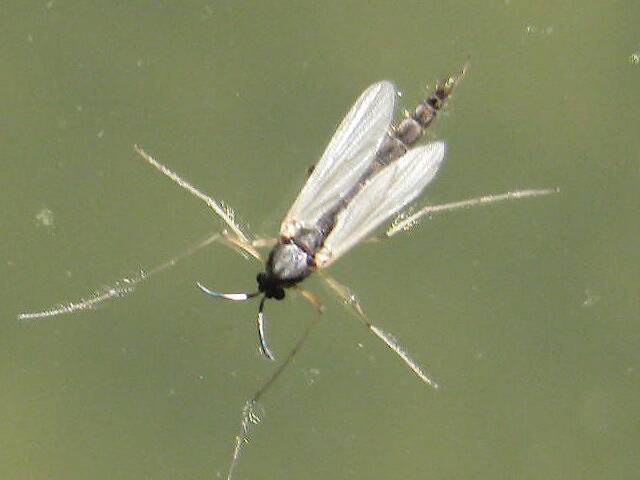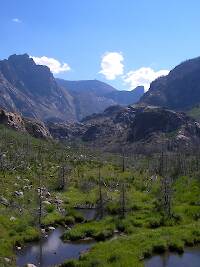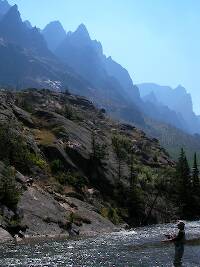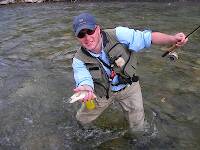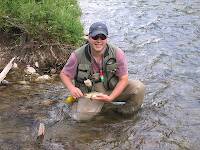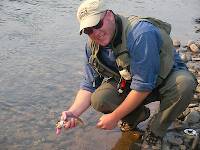
Hex Mayflies
Hexagenia limbata
The famous nocturnal Hex hatch of the Midwest (and a few other lucky locations) stirs to the surface mythically large brown trout that only touch streamers for the rest of the year.
Featured on the forum

This one seems to tentatively key to Holocentropus, although I can't make out the anal spines in Couplet 7 of the Key to Genera of Polycentropodidae Larvae nor the dark bands in Couplet 4 of the Key to Genera of Polycentropodidae Larvae, making me wonder if I went wrong somewhere in keying it out. I don't see where that could have happened, though. It might also be that it's a very immature larva and doesn't possess all the identifying characteristics in the key yet. If Holocentropus is correct, then Holocentropus flavus and Holocentropus interruptus are the two likely possibilities based on range, but I was not able to find a description of their larvae.

Troutnut is a project started in 2003 by salmonid ecologist Jason "Troutnut" Neuswanger to help anglers and
fly tyers unabashedly embrace the entomological side of the sport. Learn more about Troutnut or
support the project for an enhanced experience here.
Konchu on Jun 8, 2009June 8th, 2009, 1:24 pm EDT
On this site, alot of discussion surrounds the food of trout. But a couple of other things factor in to the survival and well-being of our scaled friends. One is water quality. The other is preferred habitat. We usually know the water is of sufficient quality, and can take it as a given, if our friends or guide tells us that trout are present. But what about the right habitat? What are some tricks for recognizing that sweet spot where the big one lurks?
One thing that I can think of is that trout need a sense of protection of some kind, mostly from danger from above in North America: birds that eat fish.
So, a limb hanging over a slow pool, where they can be as lazy as possible, might offer a good spot.
What about some other places and the rational behind the fish being there?
One thing that I can think of is that trout need a sense of protection of some kind, mostly from danger from above in North America: birds that eat fish.
So, a limb hanging over a slow pool, where they can be as lazy as possible, might offer a good spot.
What about some other places and the rational behind the fish being there?
Martinlf on Jun 8, 2009June 8th, 2009, 1:48 pm EDT
The heads and tails of pools seem to be prime spots when a hatch is on, or when spinners are falling. If there is protection, a fish may stay in such a spot, but if not they may move from a sheltering lie to these feeding lies. These have been the sweet spots for me this season, but primarily during bug activity.
"He spread them a yard and a half. 'And every one that got away is this big.'"
--Fred Chappell
--Fred Chappell
CaseyP on Jun 8, 2009June 8th, 2009, 3:45 pm EDT
the very deepest spot in the pool, especially on a bright day. logs, rocks, and sharp bends at the bottoms of riffles can all have amazingly deep holes next to them. it's hard for herons, eagles, ospreys and anglers to get to the fish. the first three threats simply can't reach them. the last have the best chance if they can get the fly down into the hole before the current washes it downstream.
"You can observe a lot by watching." Yogi Berra
Martinlf on Jun 10, 2009June 10th, 2009, 3:13 pm EDT
One good spot may be that seemingly shallow pool that has just enough cover to hold fish, but doesn't look appealing to the bait fishermen. One of my buddies and I fished just such a hole a while back and we marveled at how many big fish it held. Other deeper, more fishy holes seemed to have been cleaned out, but not this one--and at dusk, Lord.
"He spread them a yard and a half. 'And every one that got away is this big.'"
--Fred Chappell
--Fred Chappell
GONZO on Jun 12, 2009June 12th, 2009, 11:34 am EDT
Konchu,
Although the basic needs of trout (water quality/temperature, shelter, and food) don't change much except for the priority of the moment, the way each stream satisfies those needs can be very different. Differences even among streams in the same watershed can be fascinating.
Please forgive my long (probably excessive) response, but I just recommended Tom Rosenbauer's excellent Reading Trout Streams in another thread, and Louis's comments about a stream that we recently shared reminded me of a few of Rosenbauer's interesting observations. I'll paraphrase those comments and suggest the ways in which they match my experience:
Shelter vs. Food--Rosenbauer makes the very reasonable point that the availability or concentration of trout food is often the most important consideration for fly fishers because we generally catch trout when they are feeding. A trout's shelter and its feeding area could be widely separated, though places that offer both in close proximity are usually prime lies defended by somewhat larger trout. The very biggest trout in streams are sometimes exceptions to this. Knowing that a monster trout might be holding on the bottom of a deep dark pool during the day could be of limited value because the fish probably does little feeding there. (A baitfisher's earthworm patiently soaked nearby might prove irresistable, but prospects for fly fishers will be more limited.) That same fish could go on a feeding rampage all over a shallow flat from dusk to dawn, sometimes in water that will barely cover its back.
Overhead Cover--This can be a double-edged sword. Bushes and low overhanging trees, like alders, willows, or live blowdowns can provide protection from diving birds and their shade can aid vision, but higher trees with barer branches can also provide a convenient perch for a kingfisher. (As an aside, I once rounded a bend in a favorite stream only to come up-close-and-personal with an immature eagle as it was taking off from the shallows. We all know that eagles are big birds, but I couldn't have been more surprised had I encountered a pterodactyl.) Although predatory birds are a prime threat, I also fish streams with good populations of mink and even a few that host otters. Sloping rocks or banks near otherwise attractive overhead cover make good approaches for these predators. Little trout in little streams also have to worry about watersnakes and staying out of arm's reach of raccoons. Trout are not the easiest prey for any of these marauders, but those that make dumb choices (including many stocked fish) don't survive long.
Depth--Although any change in depth can be significant on tiny streams, it is often overrated as a place to find trout in larger waters. The greatest depths can provide shelter from the bright sun of middday in summer or a place to rest and avoid the dangers of anchor ice in winter, but fish that take refuge there are often hiding rather than feeding actively. More importantly, fixating on deeper pools can cause us to overlook other, more productive but less obvious places. (Especially ones that are less of a magnet to baitfishers and others.)
Riffles and Flats--I have far too often overlooked rather shallow riffles or flats, only to be surprised by what they held. The very shallow flat (on a smallish freestoner) that Louis mentions above is a perfect example. For years I passed it by, thinking that it only held youngsters. All that changed one day when I half-heartedly cast to a riser in the thin water above the tail. The tiddler that I expected turned into a fat and very strong 16" brown. And this was no hapless displaced stockie, but a savvy streambred fish. (This is a wild trout stream.) On another occasion, I was fishing a broad, nearly featureless riffle on the larger stream into which the above-mentioned stream flows. I had (somewhat grudgingly) surrendered the favorite run below to a longtime fishing partner. My rather random search of the riffle eventually and abruptly turned up a veritable gold mine of large wild browns. Those fish comprised the largest back-to-back string of hook-ups that I have ever had on that stream, and it holds some very nice browns. When I checked, they had all been holding along a long, shallow depression in the streambed that was nearly invisible until one waded into it.
Limestone Spring Creeks vs. Freestone--Rosenbauer says that trout can be "anywhere" in spring creeks. Although that might seem to be a bit of an overstatement, I think it is only overstated in that some of the places that a freestone angler might tend to look first can hold few trout. On classic meadow spring creeks, deep silt-bottomed holes can often be relatively barren, while shallow weedy flats can be tremendously productive. Sections that flow through forested areas often do not hold nearly as many (or as big) fish as the more open meadow stretches. A while back, a very experienced biologist told me that although restoring riparian vegetation is a great idea on most freestone streams, a one-size-fits-all approach to habitat restoration can actually make some spring creeks less productive. He maintained that the open meadow areas of cool, healthy spring creeks almost always hold more and better fish.
My response is already too long, Konchu, so I'll leave it at. I thought your question was interesting.
Although the basic needs of trout (water quality/temperature, shelter, and food) don't change much except for the priority of the moment, the way each stream satisfies those needs can be very different. Differences even among streams in the same watershed can be fascinating.
Please forgive my long (probably excessive) response, but I just recommended Tom Rosenbauer's excellent Reading Trout Streams in another thread, and Louis's comments about a stream that we recently shared reminded me of a few of Rosenbauer's interesting observations. I'll paraphrase those comments and suggest the ways in which they match my experience:
Shelter vs. Food--Rosenbauer makes the very reasonable point that the availability or concentration of trout food is often the most important consideration for fly fishers because we generally catch trout when they are feeding. A trout's shelter and its feeding area could be widely separated, though places that offer both in close proximity are usually prime lies defended by somewhat larger trout. The very biggest trout in streams are sometimes exceptions to this. Knowing that a monster trout might be holding on the bottom of a deep dark pool during the day could be of limited value because the fish probably does little feeding there. (A baitfisher's earthworm patiently soaked nearby might prove irresistable, but prospects for fly fishers will be more limited.) That same fish could go on a feeding rampage all over a shallow flat from dusk to dawn, sometimes in water that will barely cover its back.
Overhead Cover--This can be a double-edged sword. Bushes and low overhanging trees, like alders, willows, or live blowdowns can provide protection from diving birds and their shade can aid vision, but higher trees with barer branches can also provide a convenient perch for a kingfisher. (As an aside, I once rounded a bend in a favorite stream only to come up-close-and-personal with an immature eagle as it was taking off from the shallows. We all know that eagles are big birds, but I couldn't have been more surprised had I encountered a pterodactyl.) Although predatory birds are a prime threat, I also fish streams with good populations of mink and even a few that host otters. Sloping rocks or banks near otherwise attractive overhead cover make good approaches for these predators. Little trout in little streams also have to worry about watersnakes and staying out of arm's reach of raccoons. Trout are not the easiest prey for any of these marauders, but those that make dumb choices (including many stocked fish) don't survive long.
Depth--Although any change in depth can be significant on tiny streams, it is often overrated as a place to find trout in larger waters. The greatest depths can provide shelter from the bright sun of middday in summer or a place to rest and avoid the dangers of anchor ice in winter, but fish that take refuge there are often hiding rather than feeding actively. More importantly, fixating on deeper pools can cause us to overlook other, more productive but less obvious places. (Especially ones that are less of a magnet to baitfishers and others.)
Riffles and Flats--I have far too often overlooked rather shallow riffles or flats, only to be surprised by what they held. The very shallow flat (on a smallish freestoner) that Louis mentions above is a perfect example. For years I passed it by, thinking that it only held youngsters. All that changed one day when I half-heartedly cast to a riser in the thin water above the tail. The tiddler that I expected turned into a fat and very strong 16" brown. And this was no hapless displaced stockie, but a savvy streambred fish. (This is a wild trout stream.) On another occasion, I was fishing a broad, nearly featureless riffle on the larger stream into which the above-mentioned stream flows. I had (somewhat grudgingly) surrendered the favorite run below to a longtime fishing partner. My rather random search of the riffle eventually and abruptly turned up a veritable gold mine of large wild browns. Those fish comprised the largest back-to-back string of hook-ups that I have ever had on that stream, and it holds some very nice browns. When I checked, they had all been holding along a long, shallow depression in the streambed that was nearly invisible until one waded into it.
Limestone Spring Creeks vs. Freestone--Rosenbauer says that trout can be "anywhere" in spring creeks. Although that might seem to be a bit of an overstatement, I think it is only overstated in that some of the places that a freestone angler might tend to look first can hold few trout. On classic meadow spring creeks, deep silt-bottomed holes can often be relatively barren, while shallow weedy flats can be tremendously productive. Sections that flow through forested areas often do not hold nearly as many (or as big) fish as the more open meadow stretches. A while back, a very experienced biologist told me that although restoring riparian vegetation is a great idea on most freestone streams, a one-size-fits-all approach to habitat restoration can actually make some spring creeks less productive. He maintained that the open meadow areas of cool, healthy spring creeks almost always hold more and better fish.
My response is already too long, Konchu, so I'll leave it at. I thought your question was interesting.
Konchu on Jun 13, 2009June 13th, 2009, 2:52 am EDT
A Japanese scholar named Kinji Imanishi developed an idea referred to as sumiwake, or habitat partitioning. He also had a concept of "species societies," or the interactions with one another that maintain an equilibrium in an environment.
What are some ways that trout segregate themselves in streams? Who gets which spots?
In the short strike streamer swipers thread, chasing is being discussed. What resources that we can recognize are the bigger (and essentially more competitive) fish protecting?
What are some ways that trout segregate themselves in streams? Who gets which spots?
In the short strike streamer swipers thread, chasing is being discussed. What resources that we can recognize are the bigger (and essentially more competitive) fish protecting?
GONZO on Jun 13, 2009June 13th, 2009, 6:16 am EDT
There is a dominance hierarchy, with the biggest/fittest trout defending a choice spot and others arranged by rank (often behind it). Many fly fishers are aware of this and use it to decide where the best trout might be holding. Rosenbauer makes the point that this might not be considered territoriality in the stricter sense, because a dominant trout might change its location when feeding and will defend the new spot with equal vigor. This seems to mostly revolve around the availability/convenience of food, because a convenient shelter or safety retreat will often be shared by trout of all sizes. Rosenbauer says this about the feeding areas:
As a tangent to this discussion, one species-related difference always strikes me when I fish a headwater in which the wild browns are separated from native brook trout by barrier waterfalls: In a larger hole in the brown trout zone one might find three or four browns, yet a similarly sized hole above the barrier will be crowded with as many as ten to fifteen brook trout. One interesting aspect of this is that the combined mass of the populations utilizing a similar resource is not equal. The browns are bigger on average, and they clearly out-compete the brookies. However, their larger size does not make up for the difference in mass created by numbers of brook trout where they are not in competition with browns.
We like to call this his feeding lane but that term is somewhat misleading because the trout, if he can, will spend all his time here. It's his home. He'll defend his territory from other trout, but when he bolts into his logjam or rock pile, he'll allow all of his neighbors who have been similarly frightened to crowd right in, fins touching.
As a tangent to this discussion, one species-related difference always strikes me when I fish a headwater in which the wild browns are separated from native brook trout by barrier waterfalls: In a larger hole in the brown trout zone one might find three or four browns, yet a similarly sized hole above the barrier will be crowded with as many as ten to fifteen brook trout. One interesting aspect of this is that the combined mass of the populations utilizing a similar resource is not equal. The browns are bigger on average, and they clearly out-compete the brookies. However, their larger size does not make up for the difference in mass created by numbers of brook trout where they are not in competition with browns.
Falsifly on Jun 13, 2009June 13th, 2009, 9:46 am EDT
All this talk of a “choice spot” has invoked some very interesting and informative responses from Gonzo. In response to Konchu’s question:
I think Gonzo nailed it when he made this opening statement:
Precisely, it’s the priority of the moment that determines the choice spot. I don’t think it’s so much the priority of the fish, but the priority of nature surrounding the fish at that moment in time. I think many of us think in terms of a “choice spot” or “sweet spot” as being a static always present particular location. This is certainly not the case as Gonzo has so aptly stated. We must always remain cognizant of the dynamic nature of the fish and its habitat. Is there a trick to recognizing that “sweet spot”? I don’t know if I would call it a trick or not, I think it’s more an understanding as to how and why that “sweet spot’ moves.
What are some tricks for recognizing that sweet spot where the big one lurks?
I think Gonzo nailed it when he made this opening statement:
Although the basic needs of trout (water quality/temperature, shelter, and food) don't change much except for the priority of the moment, the way each stream satisfies those needs can be very different.
Precisely, it’s the priority of the moment that determines the choice spot. I don’t think it’s so much the priority of the fish, but the priority of nature surrounding the fish at that moment in time. I think many of us think in terms of a “choice spot” or “sweet spot” as being a static always present particular location. This is certainly not the case as Gonzo has so aptly stated. We must always remain cognizant of the dynamic nature of the fish and its habitat. Is there a trick to recognizing that “sweet spot”? I don’t know if I would call it a trick or not, I think it’s more an understanding as to how and why that “sweet spot’ moves.
Falsifly
When asked what I just caught that monster on I showed him. He put on his magnifiers and said, "I can't believe they can see that."
When asked what I just caught that monster on I showed him. He put on his magnifiers and said, "I can't believe they can see that."
GONZO on Jun 13, 2009June 13th, 2009, 10:31 am EDT
Thank you, Falsifly, but much of that response must be credited to the brilliance of Rosenbauer's book. Every time I return to that slim volume, I am struck by how much of it is confirmed by my experience. For example, the dominance hierarchy of the fish around the low overhanging tree on the flat that Louis and I fished is depicted with almost perfect accuracy in one of the illustrations in his book.
Regarding how priorities can be satisfied in different ways in different streams: On some streams that I fish, the same fish can be found in exactly the same spot day in and day out, year in and year out (with the exception of spawning season). When that fish eventually gets replaced, it will usually be by a similar-size fish. On other streams, the fish will travel long distances from one part of the watershed to another in order to find what they need. A favorite spot on a tributary will be variously occupied by smallish brook trout, larger brook trout, or out-sized browns, depending on when I fish it. The reasons have not always been apparent to me, and they don't seem to fit a consistent pattern (unlike spawning migrations). Likewise, although the feeding area preferred by a trout might be narrowly confined on some small to medium streams, I have seen the rainbows that occupy the lakelike pools and flats of the Big D cruise in elongated circuits, in just the same way that the rainbows in Skaneateles Lake feed on the Brown Drake or Hex hatches.
Regarding how priorities can be satisfied in different ways in different streams: On some streams that I fish, the same fish can be found in exactly the same spot day in and day out, year in and year out (with the exception of spawning season). When that fish eventually gets replaced, it will usually be by a similar-size fish. On other streams, the fish will travel long distances from one part of the watershed to another in order to find what they need. A favorite spot on a tributary will be variously occupied by smallish brook trout, larger brook trout, or out-sized browns, depending on when I fish it. The reasons have not always been apparent to me, and they don't seem to fit a consistent pattern (unlike spawning migrations). Likewise, although the feeding area preferred by a trout might be narrowly confined on some small to medium streams, I have seen the rainbows that occupy the lakelike pools and flats of the Big D cruise in elongated circuits, in just the same way that the rainbows in Skaneateles Lake feed on the Brown Drake or Hex hatches.
Falsifly on Jun 13, 2009June 13th, 2009, 4:13 pm EDT
Yes, it is amazing to witness how a “choice spot” can increase in size, to encompass vast areas of deep, slow moving, pools. Usually most evident in mountainous areas where one has the advantage of watching from a lofty advantage. I have had the good fortune not only to have observed large pools teaming with trout of every size, commingling as if in an harmonious effort to harvest nature’s over abundance, but also feeding in such a way as to throw caution to the wind, granting this neophyte one more opportunity of a life time, while they blissfully dine on one of nature’s most dainty. Add to that, a warm, cloudless, early spring day, with the sun at its zenith, its rays penetrating deeply into the gin clear water and reflecting from the last remnants of winters pristine white banks. Yes, a “choice spot” that only I can know. I know it because it continues to grow as a life lifting experience, one that through thick and thin, I am always able to remember, one that, in the toughest of times, comes easily to mind and lifts even the most downtrodden of spirits. I have witnessed, but even more importantly I have experienced, that “choice spot”, a spot so ingrained in my memory, that when the day comes, I wish my ashes to be spread at the head of that pool into which I hope, I shall forever, remain.
This deep reflection on “choice spots” is brought to you, compliments of Jack, and one I think appropriate to a discussion titled “home sweet home”. I apologize for Jack straying off subject, but I felt compelled to allow him to write something, well, anything really, for he is so seldom granted an opportunity to contribute.
This deep reflection on “choice spots” is brought to you, compliments of Jack, and one I think appropriate to a discussion titled “home sweet home”. I apologize for Jack straying off subject, but I felt compelled to allow him to write something, well, anything really, for he is so seldom granted an opportunity to contribute.
Falsifly
When asked what I just caught that monster on I showed him. He put on his magnifiers and said, "I can't believe they can see that."
When asked what I just caught that monster on I showed him. He put on his magnifiers and said, "I can't believe they can see that."
Pdq5oh on Jun 14, 2009June 14th, 2009, 4:04 am EDT
Water clarity seems important. I've found fish in shallow runs when the water was stained after a rain. Those same runs have been empty when water was very clear.
Phil
Quick Reply
Related Discussions
Topic
Replies
Last Reply
3
Mar 18, 2009
by Andrew
by Andrew
4
Sep 4, 2015
by PaulRoberts
by PaulRoberts
1
Sep 14, 2010
by SlateDrake9
by SlateDrake9

